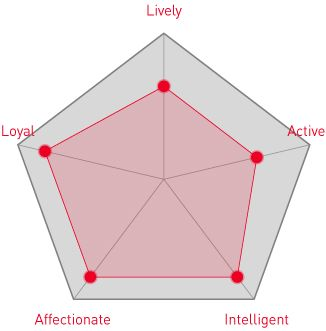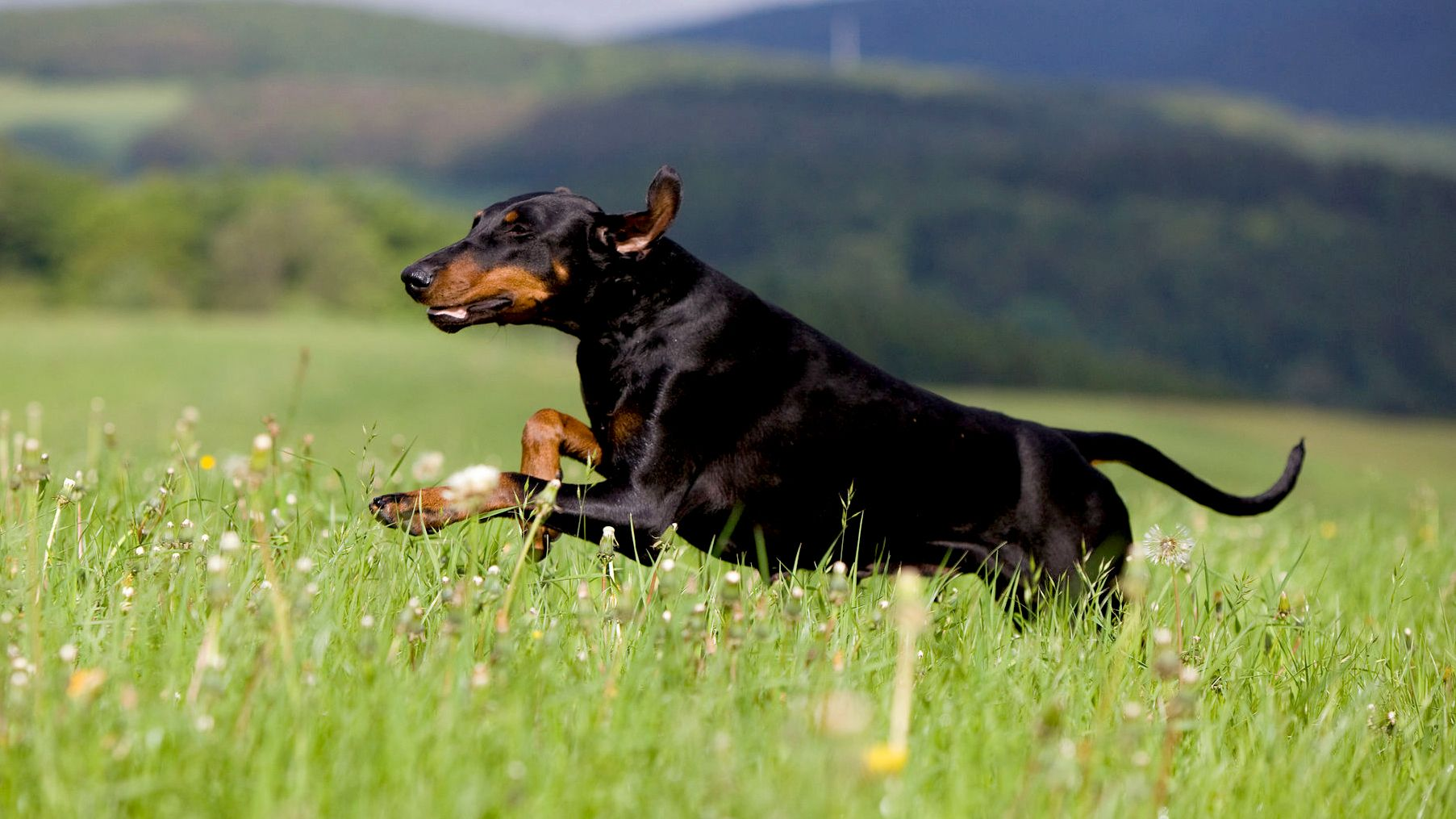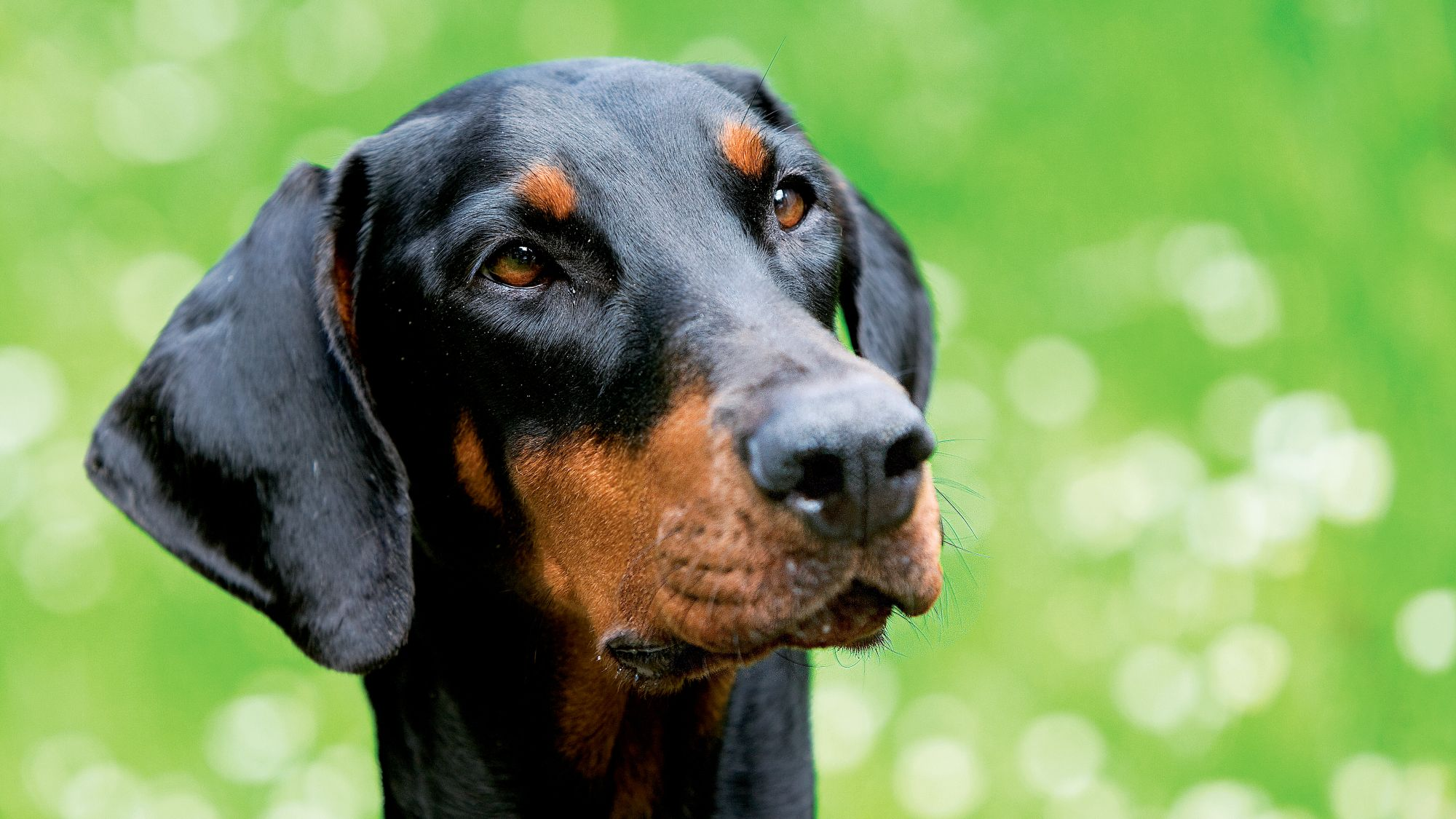
Let's talk Dobermanns
Originally bred as guard dogs in the late 1800’s, the Dobermann – or Doberman Pinscher in the US and Canada – remains a popular choice for the police and military to this day. Despite their tough-guy image, however, Dobermanns are gentle animals that are friendly, affectionate and deeply loyal to their human pack. This makes them equally great companions. Also notable for their gorgeous glossy coat, sleek and agile body and expressive features, it’s no wonder they often scoop the coveted title of ‘Best in Show’.Official name: Dobermann, Doberman Pinscher
Other names: None
Origins: Germany

| Drooling tendencies: |
|
Warm weather? | |
| Shedding level | Suited to apartment living? | ||
| Energy level (high, low, medium) *: | High | Family pet? * |
|
| Compatibility with other pets | 
|
Can stay alone?* | 
|
* We advise against leaving pets alone for long stretches. Companionship can prevent emotional distress and destructive behaviour. Speak to your veterinarian for recommendations.
Every pet is different, even within a breed; this snapshot of this breed’s specifics should be taken as an indication.
For a happy, healthy and well-behaved pet, we recommend educating and socialising your pet as well as covering their basic welfare, social and behavioural needs.
Pets should never be left unsupervised with a child.
All domestic pets are sociable and prefer company. However, they can be taught to cope with solitude from an early age. Seek the advice of your veterinarian or trainer to help you do this.


| Baby age: | Birth to 2 months |
| Puppy age: | 2 to 15 months |
| Adult age: | 15 months to 5 years |
| Mature age: | 5 to 8 years |
| Senior age: | From 8 years |

1/7
Get to know the Dobermann
All you need to know about the breed
Despite being a comparatively new breed, the Dobermann has quickly established itself as a popular dog across the world. This is especially the case in the US where they have their own distinct variety: The Doberman Pinscher. Although much the same in many ways, the American is slightly slimmer, with more defined lines, a longer arched neck and a narrower head—and even their own name!
What they both very much share in common is that special Dobermann personality. Despite their guard-dog credentials, the Dobermann is actually a very calm, friendly and docile breed once trained. They do, however, have quite a protective streak – and will have no hesitation in fending off an intruder – which is what makes them good defence dogs too.
Developed in Germany in the late 1800’s, the Dobermann is thought to be a mix of Rottweiler, German Pinscher and Black and Tan Terrier. Today, these handsome animals are notable for their sleek and agile bodies, gleaming coat and beautiful brown eyes. Medium to large in size, Dobermanns also tend to be a fairly healthy breed of dog.
Highly intelligent and super-quick learners, Dobermanns are a pleasure to train—and pretty easy to look after with their short, glossy coat. Just one word of warning though: They need a significant amount of activity – both mental and physical – in order to really thrive. But if you’re looking for a dog to spend time with – especially outdoors! – the Dobermann might just be the one for you.

2/7
2 facts about Dobermanns
1. Brains and beauty
The Dobermann is regarded as one of the most intelligent breeds of dog in the world. In fact, they rank fifth overall according to canine psychologist Stanley Coren who wrote the seminal book The Intelligence of Dogs (1994).
2. Leader of the pack
One other thing to bear in mind with the Dobermann is that, being naturally smart, they will assert themselves as top dog, given a chance. So, they really need an experienced owner who can establish themselves as ‘leader of the pack’, in the immortal words of American girl group The Shangri-Las. For more information on training your Dobermann, see below.
History of the breed
Developed in Germany in the late 1800’s, the Dobermann has a rather unusual history. In the town of Apolda, a tax collector by the name of Louis Dobermann wanted a dog to protect him on his rounds. So, he set about breeding the perfect dog for the task—and the Dobermann was the result.
Very quickly, these intelligent and agile animals gained a reputation as an ideal defence dog. As such, Dobermanns were soon utilised by the police and military—particularly in World War Two. In time, they went on to become equally popular as companion animals too.
First recognised by the German Kennel Club in 1900, another important moment came in 1908 when the Dobermann was imported to the US. There, the breed diverged into a new variety—while, back in Europe, the Pinscher part of the name was dropped. Hence how we now have two versions of the breed—both as adorable as the other.

4/7
From head to tail
Physical characteristics of Dobermanns
1. الأذنان
آذان مرنة ولكن ليست ثقيلة تتدلى بجانب رأس الكلب
2. الشعر
شعر قصير وكثيف فوق طبقة سفلية مقاومة للماء
3. الفراء
فراء يتراوح بين الأسود إلى لون الشوكولاتة أو الأصفر، ومن الكريمي الفاتح إلى المحمر
4. الذيل
ذيل منتصب وهو بطبيعته طويل ونادرًا ما يتوقف عن الاهتزاز – والجسم كله يمكن يهتز في بعض الأحيان.
5. الساقان والعمود الفقري
متناسب بشكل جيد، مع توازن جيد بين طول الساق والعمود الفقري.

5/7
Things to look out for
From specific breed traits to a general health overview, here are some interesting facts about your Dobermann

6/7
Caring for your Dobermann
Grooming, training and exercise tips
With their short, smooth coats, Dobermanns require just a weekly brush to keep that lustrous shine—though more during shedding times. Also, be prepared for occasional drooling. The Dobermann’s nails should be trimmed monthly, ears checked regularly and teeth brushed daily. In terms of training, Dobermanns will benefit from puppy classes and early socialisation, so that they know from the start who is ‘pack leader’ and because they can sometimes be a bit suspicious of other dogs. But with their innate intelligence, training is usually a pleasure for both parties. However, Dobermanns do require quite a lot of exercise – ideally three hours a day or more – so, if you’re looking for a jogging partner, you might just have found your perfect match. They can also go on to excel at canine sports such as agility, obedience and tracking.7/7
All about Dobermanns
Despite their fearsome reputation, Dobermanns are very affectionate dogs with a calm and gentle nature. So, as long as they have been socialised and trained properly, Dobermanns are generally fine with children—especially if they have been raised with them since puppyhood. As with all dogs, children should be taught how to interact with Dobermanns respectfully, however, and they shouldn’t be left unsupervised together, just in case.
Because of their background as guard dogs, Dobermanns do have a naturally protective streak and will therefore bark when they perceive a possible threat. However, this is only to alert their owners. A content Dobermann, who has been properly trained and socialised, will not generally bark excessively without good reason.
Read more on this topic


How to adopt a dog

Things to consider before getting a dog
Sources
1 - Veterinary Centers of America https://vcahospitals.com/
2 - Royal Canin Dog Encyclopaedia. Ed 2010 and 2020
3 - Banfield Pet Hospital https://www.banfield.com/
4 - Royal Canin BHN Product Book
5 - American Kennel Club https://www.akc.org/